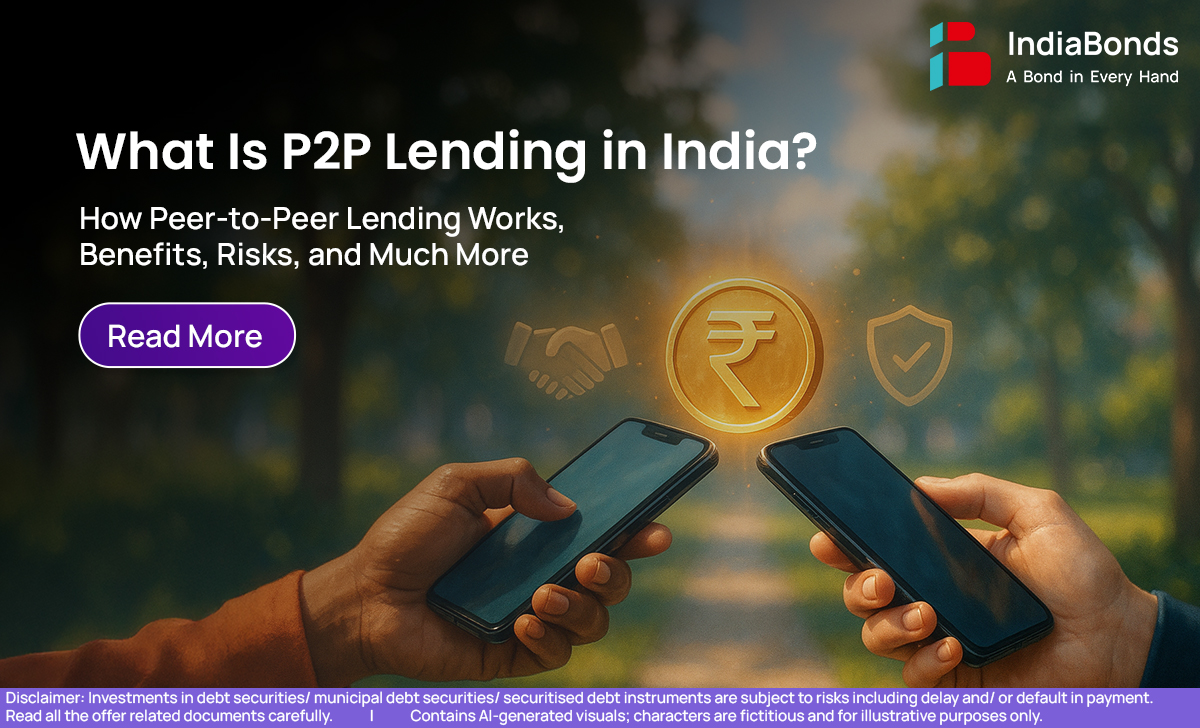What Is P2P Lending in India? How Peer-to-Peer Lending Works, Benefits, Risks, and Much More

What Is P2P Lending in India? How Peer-to-Peer Lending Works, Benefits, Risks, and Much More (Introduction)
P2P lending in India connects people who have money to lend with people who need small loans. No branch visits, no long queues. A salaried professional in Pune with surplus savings can fund a vendor in Jaipur who needs working capital for the festival rush. A regulated online platform sits in the middle, verifies both sides and manages collections. In short, p2p lending in india is a tech bridge that moves money directly between individuals, with rules from RBI to keep it orderly and transparent.
What is Peer to Peer Lending?
“Peer to peer” simply means person-to-person. Instead of a bank taking deposits and giving loans, many small lenders provide parts of a loan to a borrower through an RBI-registered platform. The platform does KYC, risk grading, documentation, and repayment tracking. When someone asks “what is peer to peer lending,” the simplest answer is: a marketplace where individuals lend to individuals using technology and basic rules to manage risk.
How P2P Lending Works in India
- A borrower applies on a platform with PAN, Aadhaar, bank statements, and income details.
- The platform checks creditworthiness and assigns a risk grade and interest range.
- Multiple lenders choose to fund small portions of the loan (say ₹1,000–₹5,000 each).
- EMI is collected monthly by the platform and split among lenders.
- Lenders see dashboards with EMI receipts, delays, and net returns.
For example, Priya in Bengaluru lends ₹25,000 spread across 25 borrowers. Each month, small EMIs flow back to her wallet. This is how p2p lending in india spreads risk—many tiny exposures instead of one big bet.
Benefits of P2P Lending for Lenders
The benefits of p2p lending come from control and diversification.
- Choice of risk–return: A conservative lender can pick better-rated borrowers; a high-return seeker can accept more risk.
- Small ticket size: Even ₹500–₹1,000 per borrower reduces concentration risk.
- Transparent tracking: Live dashboards show EMIs received, fees, and delays.
- Potentially higher yields: Because there is no large bank margin, net returns can be attractive, though never guaranteed.
Many Indian savers use p2p lending in india to complement FDs and debt funds, not to replace them.
Why Borrowers Prefer Peer to Peer Lending
- Speed: App-based journeys cut paperwork; decisions can come faster than traditional routes.
- Access: Thin-file borrowers—freelancers, early-stage entrepreneurs—often find smaller ticket loans here.
- Flexibility: Shorter tenures and smaller EMIs fit festival inventory, education fees, or medical top-ups.
- Competitive pricing: For good profiles, rates can be fair when compared with credit cards.
A shop owner in Indore, for example, may prefer this route for a ₹75,000 festive-season stock purchase with a 9–12 month payback.
Risk Management in P2P Lending
P2P lending in india carries credit risk. Sensible platforms and lenders manage it by:
- Diversification: Splitting ₹50,000 across 50–100 borrowers instead of a few.
- Risk grading: Using bureau scores, cash-flow data, and past behaviour to rate each borrower.
- Recovery processes: Reminder calls, digital follow-ups, field collections where needed.
- Provisioning mindset: Treating a portion of returns as buffer for delays or defaults.
- Realistic expectations: Understanding there is no capital guarantee, and returns vary with the cycle.
When someone asks “what is peer to peer lending” beyond the basics, the honest part is this: returns come with real, measurable risk.
Regulatory Framework by RBI
RBI regulates platforms as NBFC-P2P. Rules cap how much an individual can lend or borrow across platforms, mandate escrow accounts for fund flows, require KYC, credit assessment, and clear disclosures, and separate platform funds from client funds. This framework gives structure so that p2p lending in india does not operate like an informal chit—money moves through supervised channels with audit trails.
Is P2P Lending Right for You?
It suits a saver who understands credit risk, can diversify widely, and is comfortable locking money for the loan tenure. It may not suit someone who needs instant liquidity or expects fixed, assured returns. Many Indian investors use it as a small, satellite allocation alongside FDs, bond funds, or government schemes.
The Bottom Line
P2P lending in India is a simple idea powered by strong rails: people helping people with technology in the middle and RBI rules around it. Used thoughtfully—small tickets, wide spread, and patience—it can add a different flavour to a debt portfolio, while always respecting the risk.
FAQ
Which P2P lending is the best in India?
“Best” depends on needs. A careful investor looks for an RBI-registered NBFC-P2P, clear fee disclosure, strong credit assessment, low complaint ratios, and robust recovery practices. A platform that allows wide diversification and transparent reporting will generally suit most lenders. Shortlists should be made only after reading scheme documents and user reviews.
Is P2P lending allowed in India?
Yes. P2P lending in india is permitted under RBI regulations. Platforms must hold an NBFC-P2P licence, follow KYC rules, use escrow accounts, and disclose risks clearly. Lenders and borrowers also have exposure limits defined by RBI.
Is P2P transfer legal in India?
Yes, the lending transactions facilitated by NBFC-P2P platforms are legal. Funds move through bank-managed escrow accounts, and agreements are digitally executed. What remains important is that participants act only through regulated platforms and respect the exposure caps.
Which P2P platform is RBI approved?
Only platforms listed by RBI as NBFC-P2P are approved. An investor should verify the name on the latest RBI list before opening an account. Checking the registration status on the RBI website is the cleanest way to confirm approval before lending.
Disclaimer : Investments in debt securities/ municipal debt securities/ securitised debt instruments are subject to risks including delay and/ or default in payment. Read all the offer related documents carefully.
































